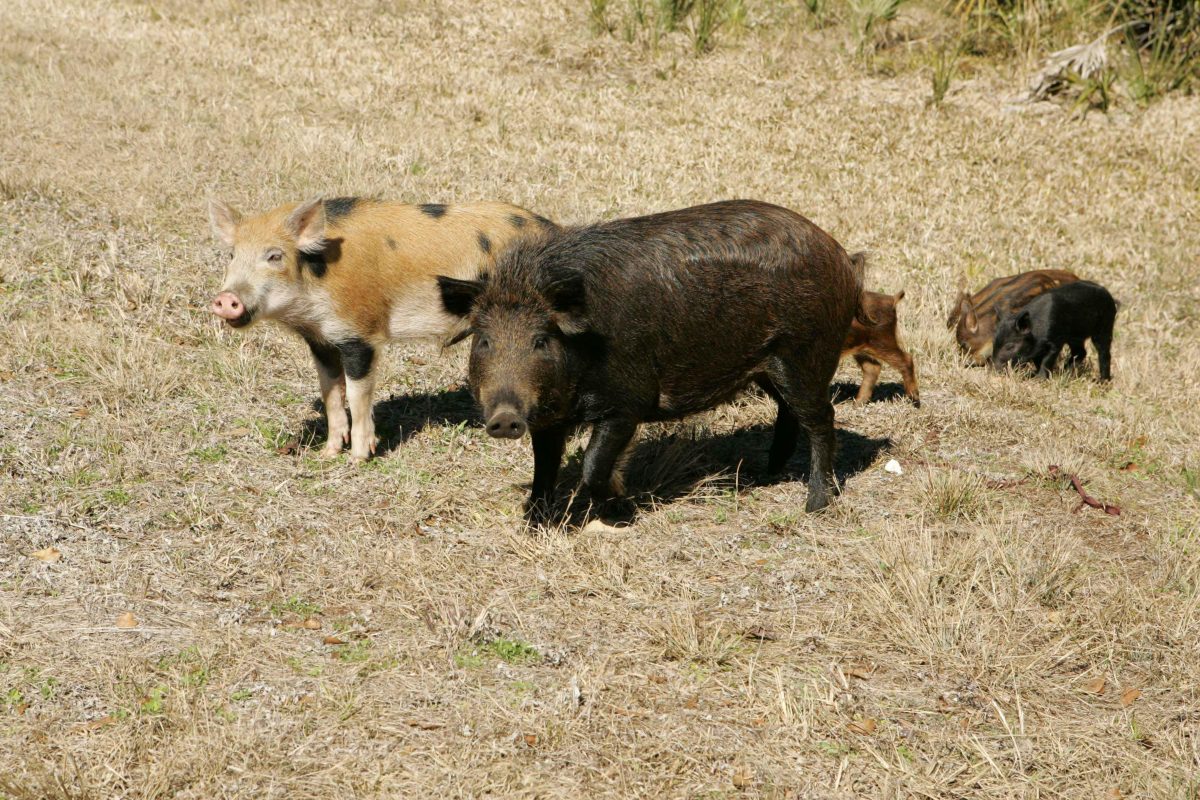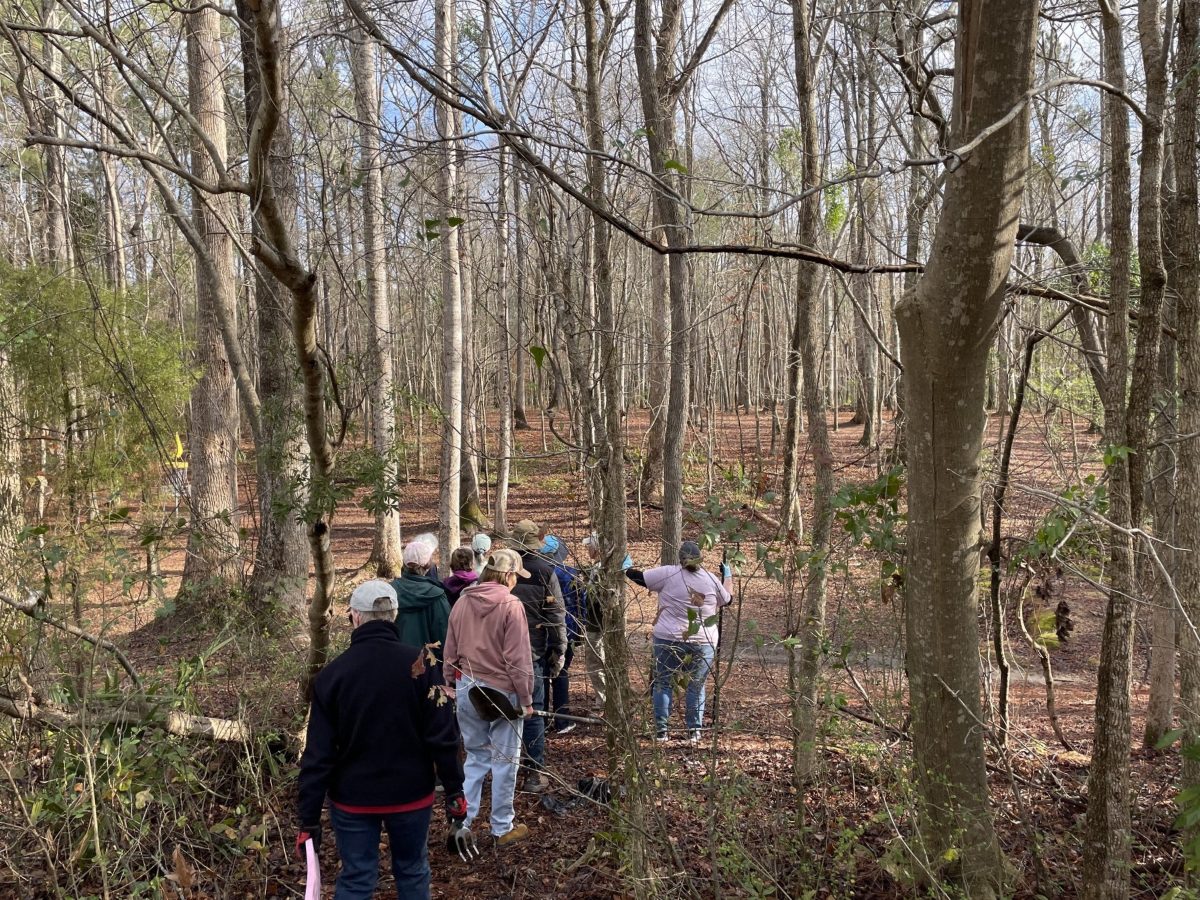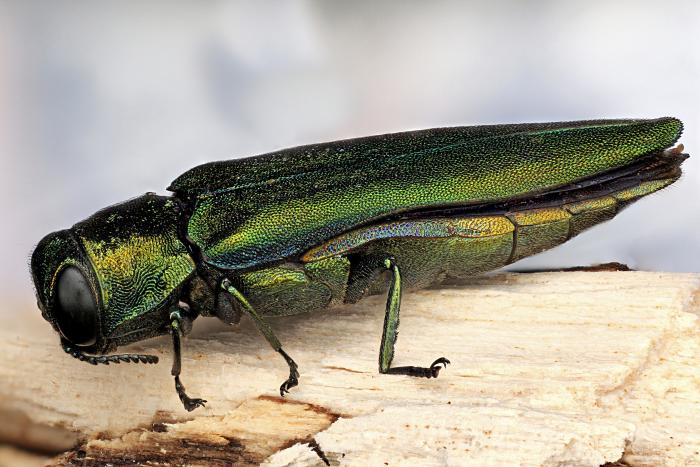
From phragmites to feral hogs, coastal North Carolina is no stranger to nonnative, invasive species taking over and damaging habitat.
“It is estimated that $34.7 billion a year are spent managing invasive plants in the United States. Introduction of invasive plants is injurious to our economy, our environment, and can even lead to human health issues,” according to the nonprofit NC Invasive Plant Council, which promotes invasive species awareness and solutions.
Supporter Spotlight
The North American Invasive Species Management Association is highlighting the threats from these types of insects, plants and animals introduced into an environment that they do not naturally exist during National Invasive Species Awareness Week this week.
The association of land and water managers, agency and nonprofits coordinated the campaign that began Monday and ends Sunday, according to its website.
Wildlife biologist Jeff Hall explained to Coastal Review that nonnative, invasive species can be threats for many reasons, including that the invasive outcompetes native species and replaces them on the landscape, “which may equal loss of the native that is similar in niche and habitat use.”
Hall specializes in herpetology, or the study of reptiles and amphibians, for the North Carolina Wildlife Resources Commission.
Another reason is that there are no predators for the invasive species. “Since it’s not native, native species have few defenses, if any, to escape and/or survive,” he said, and that can lead to loss of many natives.
Supporter Spotlight
“Some invasives cause extensive habitat damage since they are not in their normal environs,” Hall said, adding that this is especially the case with feral hogs and nutria. Plus, the invasive species could potentially introduce various diseases, fungi or other pathogens. “And since these are often new pathogens, natives have no natural defenses against.”

Here on the coast
Another charitable group is working with Craven County to help get rid of nonnative, invasive plants at its parks.
More than 20 volunteers Saturday morning from North Carolina Native Plant Society’s Central Coastal Plain Chapter helped remove Chinese privet from Creekside Park in New Bern.
“We got a lot accomplished,” Carol Peoples, co-chair of the Central Coastal Plain Chapter of the North Carolina Native Plant Society, told Coastal Review Monday about the work that took place over the weekend. “We hope that when the privet is removed, our native species will emerge from the seed bank and reestablish.”
The event held Saturday, which she called a “privet pull,” was the chapter’s second nonnative invasive species removal event. The first was held in winter 2023.
“Our chapter is working toward having more events like these in the future and they are open to the public,” Peoples added. The epicenter of the chapter is New Bern and most members reside within an hour’s drive.
Craven County Recreation and Parks Assistant Director Mark Seymour told Coastal Review that the removal Saturday went “fantastic.”
“We always welcome any chance we have to work with civic groups to clean up the parks. We don’t have any clean ups scheduled presently, but we are always eager to partner with organizations looking to help us throughout our park system,” he said, adding the county has been working on invasive species with the North Carolina Cooperative Extension, its master gardeners, and the North Carolina Native Plant Society over the last couple of years.
“These invasive plants compete with native plants that insects, reptiles, birds, and mammals need to survive,” he said.
In addition to Chinese privet, Bradford pear is another invasive identified at the county’s parks. Bradford pears have “very brittle branches that need to be constantly cleaned up after thunderstorms,” Seymour said. “We still have plenty of both throughout our parks, but with the help of these groups, along with our maintenance staff, we’re continuing to work on eliminating them from our parks.”
About invasive plants
Peoples, who is a Carteret County master gardener, said that nonnative invasive species are a threat wherever they occur, “and we have our share” in eastern North Carolina.
She explained that nonnative, invasive plants are those that have been moved by humans, on purpose or by accident, from their “home” ecoregion, which is often an entirely different continent, to a new ecoregion.
“In general, invasives share characteristics of being vigorous and aggressive growers, they sprout readily when cut, produce a lot of seeds, self-sow easily, are evergreen or leaf out earlier than native species,” Peoples continued. Adding, because these plants did not evolve to have relationships with the insects and wildlife in the new ecoregion, they have no natural enemies that curb their growth. Insects, which are vital to the local food web and ecosystem, cannot eat their leaves.
“Nonnative invasive species escape into natural areas, where they outcompete and displace native plant species. This causes a loss of native plant communities and negatively impacts the wildlife that depends on them, resulting in loss of biodiversity,” Peoples said.
The most common invasives trees that Peoples said she’s observed in the region are Bradford pear and mimosa. As for shrubs, she’s seen thorny olive, autumn olive and Chinese privet. Invasive vines are English ivy, sweet autumn virgin’s bower, Japanese honeysuckle, Japanese wisteria and Chinese wisteria. But the most common invasive herbaceous plants she’s spotted are Chinese silvergrass and Phragmites australis, or the common reed.
The NC Invasive Plant Council has ranked invasive species by region, Peoples added.
“Sadly, plant nurseries and big-box stores continue to sell most of these,” she said, and these plants continue to be purchased by homeowners and installed by landscapers and developers, compounding the problem. “Clearing invasive species from natural areas can feel like chipping away at a mountain with a spoon. The best way to control the spread of nonnative invasive species is for people to not purchase or plant them, and if they have them on their properties, to work to remove them.”
Peoples recommended the Coastal Landscapes Initiative’s free booklet, “Plant This Instead: Eco-friendly Alternatives to Harmful Ornamental Plants” available online.
“This is a guide to help our state’s coastal property owners, landscapers, and designers learn more about harmful landscaping plants, as well as North Carolina native plants that make better alternatives,” she said.
To help manage the invasive Bradford pear tree, the N.C. State Extension, the N.C. Forest Service, the N.C. Urban Forest Council, and NC Wildlife Federation properly remove and replace these invasive trees. To find out more and when the next event is taking place, visit the website.
Invasive animals
Forest Health Specialist Jim Moeller with the N.C. Forest Service told Coastal Review that he, along with fellow specialist Wayne Langston, are available to assist 58 eastern counties, and encounter invasive species in their day-to-day work.
Moeller explained that one invasive insect that is probably going to impact the coastal region soon is the emerald ash borer, which attacks all native ash trees.
This insect was first brought into the U.S. in the late 1990s, foresters suspect, and was found in Michigan in 2002. The insect was spotted in North Carolina in Granville County in 2013 and has been progressively moving east. It’s been found in Bladen, Craven and Hertford counties.

Another invasive insect to be aware of is the redbay ambrosia beetle, which he said are called “fungus formers.” These insects carry a fungus on their back, and when they bore into a tree, they introduce the fungus. The young of that beetle then eat the fungus.
“The problem is these beetles attack perfectly healthy red bay trees. The fungus spreads in the vascular system of the tree, and then it causes the tree to essentially be choked out and it wilts and dies,” he said. Though red bay is not a very commercially important species, there are a lot of different insects and animals that depend on it, including swallowtail butterflies.
The redbay ambrosia beetle was first found in Bladen County and is now in Brunswick, Onslow and Jones counties. “It hasn’t made it any further north than Carteret,” he said.
It’s believed this insect and the emerald ash borer was introduced to the area from transported packing materials.
Moeller added that these insects will travel 5 to 10 miles on their own, but humans help the spread by moving infested firewood to different parts of the state, for example.
“Our biggest threat is the unknown, the thing that’s on the horizon that we just don’t even know about,” he said.
Hall with Wildlife Resources Commission said that luckily, he sees few invasive reptile and amphibian species on the coast.
“The main invasives that I see are nutria and feral hogs, and both do quite a bit of habitat damage,” he said.
“The invasive that I worry about from a reptile perspective is the Argentinian black and white tegu,” Hall explained, referring to the large lizards, at 2 to 3 feet, and sometimes larger, “that devour anything that fits in their mouths, including many native reptiles and amphibians, ground-nesting birds, and small mammals.”
Tegus are not yet established in North Carolina and “we hope to keep it that way. We definitely hope the public will call in any sightings of this species so we can attempt to catch and remove them from the landscape.”
The Wildlife Resources Commission officials did identify two invasive species for the state last year: zebra mussels and apple snails.

The zebra mussel causes damage to waterways, filtration systems and boats. It is estimated that the U.S. spends $1 billion annually to mitigate zebra mussel damage, officials said.
“Zebra mussels can quickly take over an environment once they are established and affect the health of other aquatic wildlife by disrupting the food chain and changing the chemistry of the water. They are capable of clogging both public drinking and wastewater systems, as well as damaging recreational equipment,” the commission said in a news release.
Apple snails are a human health risk. Adult snails carry rat lungworm, which can infect humans if eaten raw or undercooked, causing a potentially fatal disease. Snail egg masses contain a toxin that can cause skin and eye rashes if they contact bare skin.
The public can report possible invasive species sightings through submitting a photo and information to the commission’s Aquatic Nuisance Species Reporting Tool. The agency’s Aquatic Nuisance Species webpage can help identify nuisance species that have been previously discovered in North Carolina.
“The best way to address invasive species is preventing their introduction in the first place,” the state agency said in response to questions. “Before planting or releasing any species, check to make sure it isn’t invasive or potentially invasive in your area.”
The agency warns that it can take time for a species to be listed as invasive, sometimes years after damage has been demonstrated, “so keep in mind that it may still have invasive potential even if it hasn’t yet been officially designated as invasive in your area.”
When it comes to managing invasives that have already been introduced to an area, “the right strategy really depends on what species is invading and how well established it has become. A good first step is to consult an expert to learn what methods will be most appropriate for you on your land,” according to the commission.
Moeller with the state Forest Service is one of those experts.
“A bulk of what we do is helping individual landowners. So somebody that has a few acres or a few hundred acres, we make recommendations for them as to how to get rid of a certain invasive plant or shrub or tree or insect,” he said. Adding if you’re concerned about an insect, disease or other forestry question, contact your county Forest Service office.








